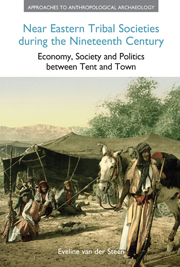 Near Eastern Tribal Societies during the Nineteenth Century
Near Eastern Tribal Societies during the Nineteenth Century What has been will be again,
what has been done will be done again;
there is nothing new under the sun.
(Ecclesiastes 1:9)Introduction
Barfield (2003) expands on the difficulties that a modern ethnographer encounters in his or her work when explaining the past. Our information, our clues about the past, are hidden in sources of a widely varying kind, each demanding a different interpretational approach. It consists of texts, archaeological sites and settlement patterns. To interpret these sources, we inevitably use the present. We use analogy, often combined with experimental archaeology. Fernand Braudel (1949) introduced the concept of the longue durée, the long, slow cycles of history that lay underneath the political, social and natural events that create the historical narrative. The current of the longue durée in a particular part of the world is determined by geography, climate and social structure, all of which change little, if at all, over time. The concept of the longue durée is the justification for the work of the ethnographer. In this study it is the justification for the continuity of tribalism, the way of life that determined society in the Near East until the beginning of the twentieth century.
To save this book to your Kindle, first ensure no-reply@cambridge.org is added to your Approved Personal Document E-mail List under your Personal Document Settings on the Manage Your Content and Devices page of your Amazon account. Then enter the ‘name’ part of your Kindle email address below. Find out more about saving to your Kindle.
Note you can select to save to either the @free.kindle.com or @kindle.com variations. ‘@free.kindle.com’ emails are free but can only be saved to your device when it is connected to wi-fi. ‘@kindle.com’ emails can be delivered even when you are not connected to wi-fi, but note that service fees apply.
Find out more about the Kindle Personal Document Service.
To save content items to your account, please confirm that you agree to abide by our usage policies. If this is the first time you use this feature, you will be asked to authorise Cambridge Core to connect with your account. Find out more about saving content to Dropbox.
To save content items to your account, please confirm that you agree to abide by our usage policies. If this is the first time you use this feature, you will be asked to authorise Cambridge Core to connect with your account. Find out more about saving content to Google Drive.